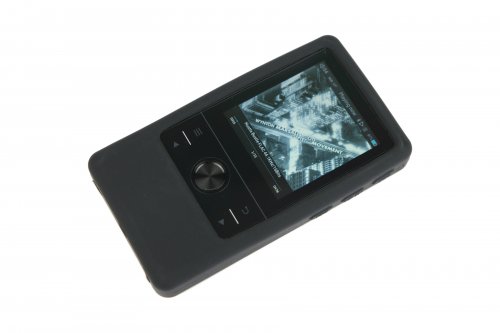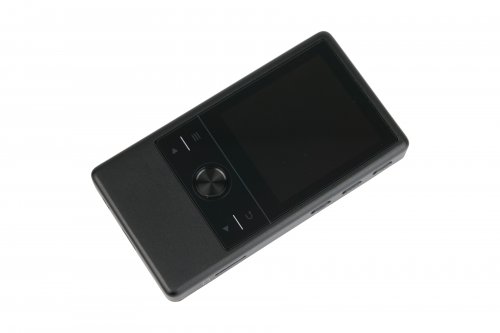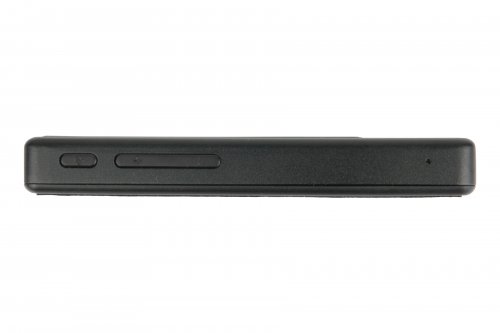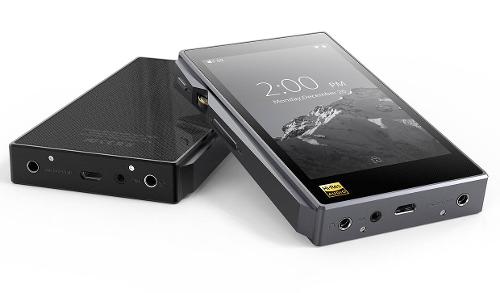Polaris – that’s the name of Campfire Audio’s newest IEMs priced at 599 USD. How do these hybrids (dynamic+BA drivers with dedicated sound chambers) perform?
Polaris are the second hybrid IEMs in Campfire Audio’s portfolio, but first featuring dedicated sound chamber for a dynamic driver. Angular shells made from anodized CNCed aluminum are already well-known, but these babies come with innovative faceplates with Cerakote coating too. Polaris is the second cheapest model (after Orion) in the company’s lineup, but it’s about to offer engaging tuning with clear highs.
Accessories
No surprises in this aspect – the accessory set is rich and includes:
● protective case
● MMCX to ⅛ jack cable
● two velcro bands
● set of single-flange tips (S, M, L sizes)
● set of thermoactive tips (S, M, L)
● set of SpinFit tips (XS, S, M, L)
● cleaning tool
● shirt clip
● manual
● warranty card
This time the protective case is made of faux leather. Its inner part is filled with shearling sheepskin imitation. The included cable is a copper-one (Litz geometry), braided, with black isolation. MMCX sockets are beryllium-covered to improve their durability. Single-flange tips are just average – similar ones can be found in many cheap IEMs. Foam tips look similar to T-series from Comply, but are also different from the foams added to Campfire Audio Andromeda. There’s also a set of SpinFit tips (moving ones) included.
Construction
At first glance, Polaris look as if they are more expensive than Andromeda. Lower price can be guessed when looking at the cable, which lacks transparent isolation and is not silver-plated. It still looks and works fine, though.
Polaris consist of three parts: black nozzles are glossy, blue anodized aluminum shells shine in an effective way and faceplates with Cerakote-coating attract one’s eyes with their grainy texture. Such a finish is known for its durability and, because of that, it’s used in space or armaments industries. For me, the overall looks is great – the combination of colors is extraordinary and no bad words can be said regarding build quality too.
Shells are deeply angular. Nozzles are dual-bore (one per each driver). Inside the shell, there are two 3D-printed chambers – the well known TEAC (Tuned Acoustic Expansion Chamber) for the BA driver and PTC (Polarity Tuned Chamber) which supports the dynamic speaker.
Gold-plated MMCX connectors are located at the top of the shell. They got letter (L and R) and dot (blue and red) indications. Braided cable features elastic ear hooks. Splitter is metal and equipped with a slider. The jack plug is gold-plated and angled.
Ergonomics
In practice angular Polaris work worse than oval, tear-shaped IEMs produced by e.g. Noble Audio, Heir Audio or Westone. An user needs to adapt, but it’s easy to get accustomed to it after a while.
First contact might cause discomfort – the IEMs are quite heavy, metal and, therefore, cold. Nozzles are appropriately shaped and the silicone and foam eartips hold safely. Level of isolation highly depends on the eartips choice – it’s best with foams and worst with single-flange tips. Spin Fit tips are elastic, but their flanges are narrow and, because of that, the application depth is crucial. I needed to put them more shallow than foam or single-flange tips and the level of isolation was inferior.
Cable works great! I enjoy such braided cords because they are light and elastic. Earhooks might be shaped to one’s needs and the given form is remembered. In case of Polaris, microphonics is not an issue. Angled jack plug is quite bulky, but special narrowing makes it compatible with devices put in additional cases.
Specs
● Balanced Armature driver + Tuned Acoustic Expansion Chamber and 8.5 mm dynamic driver + Polarity Tuned Chamber
● made of anodized CNCed aluminum ; Cerakote-coating faceplates
● frequency range: 5 Hz - 27 kHz
● sensitivity: 107 dB/mW
● impedance: 15 Ω
● Litz Copper Cable, beryllium-plated MMCX sockets
Sound
IEMs/Cans: Campfire Audio Andromeda, Noble Audio Savant i Noble 4, Etymotic ER-4PT, RHA CL750, Brainwavz B200, FiiO F5
DAC/AMP and AMPs: Burson Conductor Virtuoso (Sabre), RHA DACAMP L1, AIM SC808, ODAC i O2, Leckerton UHA-760, Zorloo ZuperDAC
DAPs: iBasso DX200, FiiO X5 III, iBasso DX90, OnePlus 5
Interconnects: Forza AudioWorks Copper Series, Klotz
Music: various genres and realizations, including 24-bit and binaural tracks
I mainly used thermoactive foams, which, in my opinion, work best with the IEMs, but silicone tips also offer proper signature.
Polaris sound like a hybrid IEMs, but the soft low-end perfectly combines with the stronger mid- and high tones. Unlike Andromeda, Jupiter or Orion, the IEMs in focus don’t concentrate as much on the midrange. Both edges are accented, but it wouldn’t be fair to call Polaris V-shaped. If someone insists on such an expression, though, then Polaris is mild V-shaped earphone, which doesn’t lack resolution, clarity and details. The bass isn’t overwhelming and music genres choice isn’t limited. Overall, the tonality of the IEMs is very clear and direct. It’s fun, but served in a pretty analytical way.
Bass needs a short warm-up. At first, its response is evidently emphasized, but then it weakens. Low tones amounts are not extreme – they are a bit accented, but without exaggeration. Subbass and midbass are more powerful, but aren’t dominating and don’t bleed into other ranges. Low tones are typical for a dynamic driver: massive and soft. Bass isn’t hard or raw, which is characteristic for Balanced Armature speakers. The signature is more fun, very dynamic and well-controlled. It works well with both digital samples or live instruments – a double bass won’t become a subwoofer. The amount of details is also high and the texture of instruments is clearly differentiated.
Although midrange is not a priority, it’s still impressive: clear, transparent, studio-like. This frequency range isn’t too warm or too cold and it isn’t too dark or too sharp either. Polaris indeed offers crystal-clear tuning. The sound is fresh and direct, without any distance – everything stays forward. At the same time, the tuning isn’t very natural – Andromeda or Jupiter offer stronger midrange, more vivid sound. In case of Polaris one can hear some declines in upper bass and lower midrange, especially when it comes to male voices. The latter remain close, but become more flat. The same can be said about the tones of low guitar strings or a piano. Modern electro music benefits from such a tuning, but, luckily, jazz, blues or various rock sound good as well. Sound source is, however, also of high importance.
Transition between mid and high tones is smooth (more than in case of bass and lower midrange). The highs are strong and bright, of no lower priority than the lows. Top range is extended and enhanced, but the sibilance is not present. High tones make the sound very clear – Polaris won’t suit a basshead or a treblehead, but someone who values both great lows and extended highs. Trebles are also well-controlled, clear and precise – separate hits of the percussion can be distinguished. Highs don’t merge and blur, don’t hiss or rustle. Bows, clarinets, wind or keyboard instruments are not subdued and female voices also climb high, while samples level of ‘digitiality’ is appropriate.
Holographics also need to be appreciated. The soundstage is wide, with clearly distinguishable stereophony – the sound is clearly splitted between the two channels. Depth is also fine – individual sounds are put in front or around listener’s shoulders. There’s also a lot of air, so instruments are clearly separated, with a lot of distance between them.
Campfire Audio Polaris vs Andromeda vs other IEMs
A clash between hybrid, dual-driver Polaris vs 5xBA Andromeda is not as self-evident as it might seem. In technical terms, Andromeda performs better with fuller and closer midrange, more complete, natural and balanced signature. They provide great bass as well as close and vivid midrange plus extended highs. Their sound is more technical and more audiophile-like. On the contrary, Polaris offers quite special, original tuning – a combination of dynamic lows with armature-like highs works perfect! The bass is juicy, with rumbling subbass. I love Andromeda and I can say the same about Polaris – the choice depends on certain conditions. Andromeda is much more expensive, but at the same time more universal – it will perform well in new or old, soft and hard music. If, however, someone is looking for a more energetic tuning with powerful lows, then Polaris is a better choice.
At this moment, other comparisons should be more or less obvious. Etymotic ER-4PT/ER-4S offer much more forward and more even midrange, thinner bass, more analytical and less airy signature. The same might be said about Noble Audio 4 and Noble Audio Savant, which provide closer midrange, but lack some bass and the provided sound is not as ‘fun’. Campfire Audio Jupiter prioritize the midrange and the edges, when compared to Polaris, are not so extended. RHA CL750, on the other hand, offer similar clarity, space and soft bass, but Polaris feature softer mids and more accented lows.
Campfire Audio Polaris vs sources
Polaris pairs well with both smartphones and expensive DAPs. It scales with the gear and is sensitive to its signature. Neutral and more bass-heavy sources will work fine – low tones of Polaris aren’t extremely strong, so pushing them up isn’t harmful. I would, however, pay attention to sharp and bright sources as further accented highs could be fatiguing or cause lower midrange recession.
Leckerton UHA760 worked great with Campfire Audio IEMs using Balanced Armature drivers, but it’s performing a bit worse with hybrids -– the sound is at times too thin. Lighter, more mid-forward music turns out better and the bass in new electro music is not as strong. RHA DACAMP L1 is a better choice for goa trance, psychodelic trance or drum’n’bass - the bass rumble was stronger plus more massive and the highs weren’t harsh at all.
There were no surprises regarding cooperation with various DAPs. Massive lows in iBasso DX200 led to improvement of dynamics and speed while mid- and high tones remained non-fatiguing. Resolution and soundstage were impressive too. FiiO X5 III’s lows weren’t disappointing either, but mids and highs have become smoother and softer. Overall tuning has become more pleasant, but with smaller soundstage. In case of FiiO DAP the hiss between tracks was more audible, but not very intense. On the contrary, iBasso DX90 offered clearer signal with stronger midrange, accented lows and non-exaggerated highs. Polaris+OnePlus 5 tandem also worked fine, but the sound was thinner than in case of DAPs offering reduced subbas and a bit brighter tuning.
Campfire Audio Polaris + silver-plated Litz cable
Stock cable doesn’t limit Polaris’s capabilities, but the IEMs also work well with the silver-plated cable that’s added to Campfire Audio Andromeda. The sound doesn’t alter much – subbass seems yet deeper and more massive. Bass and midrange are not as soft, which can make the sound less pleasant. High tones response is improved, as if the Balanced Armature driver received a bigger share.
Verdict
Campfire Audio Polaris successfully combine two types of drivers. If someone enjoys fun tuning, the effect is sensational. Polaris is also a great choice for music lovers who lack bass in pure-BA IEMs. Campfire Audio’s IEMs seem to link the opposites – the sound simultaneously delights with its edges (deep bass and strong highs) as well as with clear mids. I find mid tones to be of lower priority and there are some shortcomings in the lower midrange, which show in male vocals. Paradoxically, this issue doesn’t limit the choice of genres – vocals remain direct and clear, but their character gets a bit different.
Polaris are not cheap, but are almost twice cheaper than Andromeda. In technical terms, their sound is impressive and the same can be said about their looks. I would choose Polaris instead of Jupiter and I would also consider spending more money on Polaris rather than choosing Etymotic ER4XR. In the last case, the decision will depend on one’s demand on midrange (ER4XR) and bass (Polaris).
maciux - Maciej Sas
Polaris are the second hybrid IEMs in Campfire Audio’s portfolio, but first featuring dedicated sound chamber for a dynamic driver. Angular shells made from anodized CNCed aluminum are already well-known, but these babies come with innovative faceplates with Cerakote coating too. Polaris is the second cheapest model (after Orion) in the company’s lineup, but it’s about to offer engaging tuning with clear highs.
Accessories
No surprises in this aspect – the accessory set is rich and includes:
● protective case
● MMCX to ⅛ jack cable
● two velcro bands
● set of single-flange tips (S, M, L sizes)
● set of thermoactive tips (S, M, L)
● set of SpinFit tips (XS, S, M, L)
● cleaning tool
● shirt clip
● manual
● warranty card
This time the protective case is made of faux leather. Its inner part is filled with shearling sheepskin imitation. The included cable is a copper-one (Litz geometry), braided, with black isolation. MMCX sockets are beryllium-covered to improve their durability. Single-flange tips are just average – similar ones can be found in many cheap IEMs. Foam tips look similar to T-series from Comply, but are also different from the foams added to Campfire Audio Andromeda. There’s also a set of SpinFit tips (moving ones) included.
Construction
At first glance, Polaris look as if they are more expensive than Andromeda. Lower price can be guessed when looking at the cable, which lacks transparent isolation and is not silver-plated. It still looks and works fine, though.
Polaris consist of three parts: black nozzles are glossy, blue anodized aluminum shells shine in an effective way and faceplates with Cerakote-coating attract one’s eyes with their grainy texture. Such a finish is known for its durability and, because of that, it’s used in space or armaments industries. For me, the overall looks is great – the combination of colors is extraordinary and no bad words can be said regarding build quality too.
Shells are deeply angular. Nozzles are dual-bore (one per each driver). Inside the shell, there are two 3D-printed chambers – the well known TEAC (Tuned Acoustic Expansion Chamber) for the BA driver and PTC (Polarity Tuned Chamber) which supports the dynamic speaker.
Gold-plated MMCX connectors are located at the top of the shell. They got letter (L and R) and dot (blue and red) indications. Braided cable features elastic ear hooks. Splitter is metal and equipped with a slider. The jack plug is gold-plated and angled.
Ergonomics
In practice angular Polaris work worse than oval, tear-shaped IEMs produced by e.g. Noble Audio, Heir Audio or Westone. An user needs to adapt, but it’s easy to get accustomed to it after a while.
First contact might cause discomfort – the IEMs are quite heavy, metal and, therefore, cold. Nozzles are appropriately shaped and the silicone and foam eartips hold safely. Level of isolation highly depends on the eartips choice – it’s best with foams and worst with single-flange tips. Spin Fit tips are elastic, but their flanges are narrow and, because of that, the application depth is crucial. I needed to put them more shallow than foam or single-flange tips and the level of isolation was inferior.
Cable works great! I enjoy such braided cords because they are light and elastic. Earhooks might be shaped to one’s needs and the given form is remembered. In case of Polaris, microphonics is not an issue. Angled jack plug is quite bulky, but special narrowing makes it compatible with devices put in additional cases.
Specs
● Balanced Armature driver + Tuned Acoustic Expansion Chamber and 8.5 mm dynamic driver + Polarity Tuned Chamber
● made of anodized CNCed aluminum ; Cerakote-coating faceplates
● frequency range: 5 Hz - 27 kHz
● sensitivity: 107 dB/mW
● impedance: 15 Ω
● Litz Copper Cable, beryllium-plated MMCX sockets
Sound
IEMs/Cans: Campfire Audio Andromeda, Noble Audio Savant i Noble 4, Etymotic ER-4PT, RHA CL750, Brainwavz B200, FiiO F5
DAC/AMP and AMPs: Burson Conductor Virtuoso (Sabre), RHA DACAMP L1, AIM SC808, ODAC i O2, Leckerton UHA-760, Zorloo ZuperDAC
DAPs: iBasso DX200, FiiO X5 III, iBasso DX90, OnePlus 5
Interconnects: Forza AudioWorks Copper Series, Klotz
Music: various genres and realizations, including 24-bit and binaural tracks
I mainly used thermoactive foams, which, in my opinion, work best with the IEMs, but silicone tips also offer proper signature.
Polaris sound like a hybrid IEMs, but the soft low-end perfectly combines with the stronger mid- and high tones. Unlike Andromeda, Jupiter or Orion, the IEMs in focus don’t concentrate as much on the midrange. Both edges are accented, but it wouldn’t be fair to call Polaris V-shaped. If someone insists on such an expression, though, then Polaris is mild V-shaped earphone, which doesn’t lack resolution, clarity and details. The bass isn’t overwhelming and music genres choice isn’t limited. Overall, the tonality of the IEMs is very clear and direct. It’s fun, but served in a pretty analytical way.
Bass needs a short warm-up. At first, its response is evidently emphasized, but then it weakens. Low tones amounts are not extreme – they are a bit accented, but without exaggeration. Subbass and midbass are more powerful, but aren’t dominating and don’t bleed into other ranges. Low tones are typical for a dynamic driver: massive and soft. Bass isn’t hard or raw, which is characteristic for Balanced Armature speakers. The signature is more fun, very dynamic and well-controlled. It works well with both digital samples or live instruments – a double bass won’t become a subwoofer. The amount of details is also high and the texture of instruments is clearly differentiated.
Although midrange is not a priority, it’s still impressive: clear, transparent, studio-like. This frequency range isn’t too warm or too cold and it isn’t too dark or too sharp either. Polaris indeed offers crystal-clear tuning. The sound is fresh and direct, without any distance – everything stays forward. At the same time, the tuning isn’t very natural – Andromeda or Jupiter offer stronger midrange, more vivid sound. In case of Polaris one can hear some declines in upper bass and lower midrange, especially when it comes to male voices. The latter remain close, but become more flat. The same can be said about the tones of low guitar strings or a piano. Modern electro music benefits from such a tuning, but, luckily, jazz, blues or various rock sound good as well. Sound source is, however, also of high importance.
Transition between mid and high tones is smooth (more than in case of bass and lower midrange). The highs are strong and bright, of no lower priority than the lows. Top range is extended and enhanced, but the sibilance is not present. High tones make the sound very clear – Polaris won’t suit a basshead or a treblehead, but someone who values both great lows and extended highs. Trebles are also well-controlled, clear and precise – separate hits of the percussion can be distinguished. Highs don’t merge and blur, don’t hiss or rustle. Bows, clarinets, wind or keyboard instruments are not subdued and female voices also climb high, while samples level of ‘digitiality’ is appropriate.
Holographics also need to be appreciated. The soundstage is wide, with clearly distinguishable stereophony – the sound is clearly splitted between the two channels. Depth is also fine – individual sounds are put in front or around listener’s shoulders. There’s also a lot of air, so instruments are clearly separated, with a lot of distance between them.
Campfire Audio Polaris vs Andromeda vs other IEMs
A clash between hybrid, dual-driver Polaris vs 5xBA Andromeda is not as self-evident as it might seem. In technical terms, Andromeda performs better with fuller and closer midrange, more complete, natural and balanced signature. They provide great bass as well as close and vivid midrange plus extended highs. Their sound is more technical and more audiophile-like. On the contrary, Polaris offers quite special, original tuning – a combination of dynamic lows with armature-like highs works perfect! The bass is juicy, with rumbling subbass. I love Andromeda and I can say the same about Polaris – the choice depends on certain conditions. Andromeda is much more expensive, but at the same time more universal – it will perform well in new or old, soft and hard music. If, however, someone is looking for a more energetic tuning with powerful lows, then Polaris is a better choice.
At this moment, other comparisons should be more or less obvious. Etymotic ER-4PT/ER-4S offer much more forward and more even midrange, thinner bass, more analytical and less airy signature. The same might be said about Noble Audio 4 and Noble Audio Savant, which provide closer midrange, but lack some bass and the provided sound is not as ‘fun’. Campfire Audio Jupiter prioritize the midrange and the edges, when compared to Polaris, are not so extended. RHA CL750, on the other hand, offer similar clarity, space and soft bass, but Polaris feature softer mids and more accented lows.
Campfire Audio Polaris vs sources
Polaris pairs well with both smartphones and expensive DAPs. It scales with the gear and is sensitive to its signature. Neutral and more bass-heavy sources will work fine – low tones of Polaris aren’t extremely strong, so pushing them up isn’t harmful. I would, however, pay attention to sharp and bright sources as further accented highs could be fatiguing or cause lower midrange recession.
Leckerton UHA760 worked great with Campfire Audio IEMs using Balanced Armature drivers, but it’s performing a bit worse with hybrids -– the sound is at times too thin. Lighter, more mid-forward music turns out better and the bass in new electro music is not as strong. RHA DACAMP L1 is a better choice for goa trance, psychodelic trance or drum’n’bass - the bass rumble was stronger plus more massive and the highs weren’t harsh at all.
There were no surprises regarding cooperation with various DAPs. Massive lows in iBasso DX200 led to improvement of dynamics and speed while mid- and high tones remained non-fatiguing. Resolution and soundstage were impressive too. FiiO X5 III’s lows weren’t disappointing either, but mids and highs have become smoother and softer. Overall tuning has become more pleasant, but with smaller soundstage. In case of FiiO DAP the hiss between tracks was more audible, but not very intense. On the contrary, iBasso DX90 offered clearer signal with stronger midrange, accented lows and non-exaggerated highs. Polaris+OnePlus 5 tandem also worked fine, but the sound was thinner than in case of DAPs offering reduced subbas and a bit brighter tuning.
Campfire Audio Polaris + silver-plated Litz cable
Stock cable doesn’t limit Polaris’s capabilities, but the IEMs also work well with the silver-plated cable that’s added to Campfire Audio Andromeda. The sound doesn’t alter much – subbass seems yet deeper and more massive. Bass and midrange are not as soft, which can make the sound less pleasant. High tones response is improved, as if the Balanced Armature driver received a bigger share.
Verdict
Campfire Audio Polaris successfully combine two types of drivers. If someone enjoys fun tuning, the effect is sensational. Polaris is also a great choice for music lovers who lack bass in pure-BA IEMs. Campfire Audio’s IEMs seem to link the opposites – the sound simultaneously delights with its edges (deep bass and strong highs) as well as with clear mids. I find mid tones to be of lower priority and there are some shortcomings in the lower midrange, which show in male vocals. Paradoxically, this issue doesn’t limit the choice of genres – vocals remain direct and clear, but their character gets a bit different.
Polaris are not cheap, but are almost twice cheaper than Andromeda. In technical terms, their sound is impressive and the same can be said about their looks. I would choose Polaris instead of Jupiter and I would also consider spending more money on Polaris rather than choosing Etymotic ER4XR. In the last case, the decision will depend on one’s demand on midrange (ER4XR) and bass (Polaris).
maciux - Maciej Sas


































































